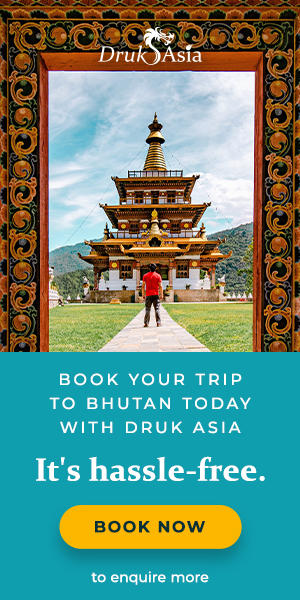What are the zhey dances in Bhutan?
There are a fixed number of steps in each dance, and each step has its own significance.

“Zhey” literally means “dance”, referring to a traditional folk dance of Bhutan. There is singing and dancing to tunes of rapid rhyme. Throughout the performance, the movements are rigorous and the dancers take firm steps as they gradually increase in pace.
There are a specific number of steps to take, and each step has its significance.
Zhey is performed by only the men.
The history of zhey dances
Legend has it that Tshangpa Jarey, the founder of the Drukpa Kagyu sect, wanted to build a Drukpa temple. But there was a demon in the form of a tortoise at the site, setting him back on the work. It was frustrating. Thus, he created a song and dance known as zhey.
In the song, he claimed to be the son of Pelden Drukpa and therefore unbeatable. With the zhey, he defeated the demon and completed the temple.
The great Lama Zhabdrung Ngawang Namgyal first fled to Bhutan from Tibet in 1616. Upon arriving at the northern border at Gasa, he was welcomed by the local Bhutanese, who performed zhey as a mark of their devotion.
And zhey has been a part of Bhutanese tradition since.
Variations of the zhey dance
Different districts in Bhutan have their own version of the zhey dance.
The basic themes of the zhey in different districts are more or less the same, but there are small differences like the dress code and dance steps. The 4 main zhey styles are:
- Goen Zhey (Gasa)
- Wang Zhey (Thimphu)
- Nub Zhey (Trongsa)
- Wochubi Zhey (Paro)
Apart from those 4 main districts, other districts have also developed their own zhey, although some are no longer practiced:
- Ngayngbi (Bumthang)
- Kabjisa Zhey (Punakha)
- Do Zhey (Paro)
- Kawang Zhey (Thimphu)
Zhey dance steps
Each zhey has its own characteristics — number of dancers, dance steps, dress code, etc — as we’ll see soon.
Included is a sample of the Goen Zhey dance steps. The other zhey, although not included here, have similar moves.
Goen Zhey (Gasa)
This is the original and oldest version of zhey, performed to receive the Lama Zhabdrung Ngawang Namgyal upon his arrival to Bhutan.
The significant verses of the song welcoming him are:
From the east, there always rises a sun; but the sun
that rises today is much warmer.
From Tibet, lamas have always come; but the lama
who comes today brings more blessings.
Number of dancers: 21
Number of steps: 13
Dance steps:
1 - Sa-chak, dedicated to the initiation.
2 - Chak-tshelma, dedicated to commemorate spiritual teachers, deities, and ancestors.
3 - Shar-pharley-thridu, dedicated to guests of the occasion.
4 - Tshopa-namyang-tshok, dedicated to the gathering.
5 - Norbu-dungkar, acknowledging the preciousness of conch in Buddhism.
6 - Tsel-sum-pa, dedicated to the three powerful forces: sky, sun, and rays.
7 - Zhuk-drel, dedicated to the excellence of the assembly line.
8 - Pa-tsha, dedicated to the usefulness of the cane.
9 - Chamshok, dedicated to the dance itself.
10 - Jachen-ngangpa, dedicated to the giant swan.
11 - Meto-kumud, offering of lotus and water to the deities.
12 - Thridu-nyima-jugjug, dedicated to the wellbeing of the spiritual teachers, deities, and ancestros.
13 - Chaluk-lekchi-chaluk-lek, concluding prayer.
Dress code: The lead dancer wears a chamok (helmet) and colourful scarf. Meanwhile, the others wear a kopak (headband) and a plain white scarf. Each dancer wears a red woolen gho (robe), black tego (undershirt), yuelham (traditional boots), and a pata (sword).
Wang Zhey (Thimphu)
Zhabdrung Ngawang Namgyal’s followers performed this dance when he just arrived in the Thimphu valley.
Number of dancers: 12
Number of steps: 14
Dress code: Dancers are bare-headed. They wear gho made of raw silk which signifies the sovereignty and independence of Bhutan. They also wear a silk meyo (knee-length skirt) which points to protection against negative influence. Each dancer carries a kabney (white scarf) as a sign of respect to the Lama. On their foot is dralham (traditional boots made of leather and silk), which represent subduing the enemies of the country. Around their head is a headband of 5 colours, also made of silk, to signify spreading the Lama’s blessings to all mankind.
Nub Zhey (Trongsa)
The people of Jee village perform Nub Zhey for the local deities. The people of the village speak Zha ked, which led to the name of their zhey, Nub Zhey.
Number of steps: 22
Dress code: The dancers wear a red gho which symbolises devotion to Buddhism. A blue tego signifies the medicinal herbs in the country. Meanwhile, they also wear a khamar (white kabney with a red/white/blue stripe down either edge) which represents the vow of adherence to the precepts. Ko Ilham (traditional knee-length boots) for the ability to bring all the eastern regions under control. Dungkar-gi along (conch shell finger ring) signifies victory over the invaders. Last but not least, a thoe (ring-like headband) for the Lama’s teachings.
Wochubi Zhey (Paro)
This version of zhey was introduced by the people from Wochu of Dzongdrakha monastery.
Number of steps: 18
Dress code: The dancers wear a headband made of green leaves, black tego, khamar, and yuelham. Their dressing symbolises a pigeon.
Witness a zhey!
Zhey is performed on special occasions like the tshechu or traditional ceremonies.
Of course, there is nothing like watching a performance for yourself. So travel to Bhutan to witness:
- Goen Zhey at Gasa Tshechu
- Nub Zhey at Trongsa Tshechu
- Wochubi Zhey at Paro Tshechu




